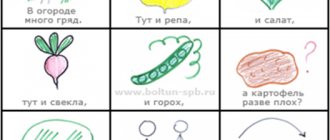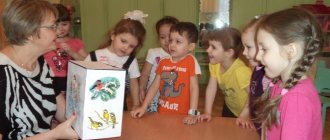“Development of children’s coherent speech through theatrical and play activities.”
2.1. Development of coherent speech in children of senior preschool age.
Speech, a wonderful gift of nature, is not given to a person from birth. It takes time for the child to start talking. And adults must make a lot of effort so that the child’s speech develops correctly and in a timely manner.
A preschool educational institution develops all children's inclinations and abilities, and among them there is nothing more significant and important in importance than the ability to speak. Therefore, systematic teaching of speech, methodical development of speech and language form the basis of the entire system of education in kindergarten. During the period of preschool childhood, significant changes occur in the thinking of children: their horizons expand, mental operations improve, new knowledge and skills appear, and therefore speech improves. [33 In the development of coherent speech, the close connection between the speech and mental development of children, the development of their thinking, perception, and observation is clearly evident. In order to talk about something well and coherently, you need to clearly imagine the object of the story (object, event), be able to analyze, select the main (for a given communication situation) properties and qualities, establish cause-and-effect, temporal and other relationships between objects and phenomena. Observing various phenomena of the surrounding life (nature, everyday life, the work of adults, etc.), great importance is given to the development of coherent speech in children. The sky, water and earth, fields and forests, thunderstorms, the sound of the wind, the colors of golden autumn, the awakening of nature in spring - all this has an emotional impact on the child and encourages him to speak out. The possibility of repeated observations creates conditions for the correct consolidation of what is perceived in speech and provides material for comparison, generalization, and description of objects and phenomena. By observing nature, a child learns to find and correctly explain the relationship between objects and their changes in accordance with time, circumstances, i.e. explain the essence of the phenomenon. He begins to use sentences involving composition and submission. The methods and techniques we select for the development of coherent speech ensure conscious, deep and lasting mastery of the native language. Therefore, we strive to ensure that children accurately convey the results of observations. [2]
The development of coherent speech in children is carried out in the process of everyday life, as well as in educational activities. The ability to coherently, consistently accurately and figuratively express one’s thoughts also influences aesthetic development. When composing his stories, the child tries to use figurative words and expressions. Some children do not pronounce correctly all the sounds of their native language, do not know how to use intonation means of expression, or regulate the speed and volume of speech depending on the situation. There are also errors in the formation of different grammatical forms (genitive plural of nouns, agreement of nouns with adjectives, different ways of word formation). And, of course, a number of children find it difficult to construct complex syntactic structures, which leads to incorrect combination of words into a sentence and disruption of the connection between sentences in a coherent statement. And therefore, the development of coherent speech is inseparable from solving other problems of speech development: enriching and activating the vocabulary, forming the grammatical structure of speech, nurturing the sound culture of speech. Thus, in the process of vocabulary work, the child accumulates the necessary vocabulary, gradually masters the ways of expressing certain content in words, and ultimately acquires the ability to express his thoughts most accurately and completely. [7; 8; 15] It is important to remember that children first move to a coherent sentence in stories of a calm, narrative nature. When conveying events that caused vivid emotional experiences, the child lingers longer on the situational-expressive presentation. Thus, when children reach senior preschool age, coherent speech reaches a fairly high level. The child answers questions with fairly accurate, brief or detailed (if necessary) answers. The ability to evaluate the statements and answers of comrades, supplement or correct them is developed. In retelling literary works (fairy tales or short stories), children learn to coherently, consistently and expressively present the finished text without the help of an adult, intonationally conveying the dialogue of the characters and the characteristics of the characters. In storytelling based on a picture, the ability to come up with a title for a story in accordance with the content is developed. When talking about toys (or a set of toys), children are taught to compose stories and fairy tales, observing the composition and expressive image of the text. When choosing appropriate characters to tell, children give their descriptions and characteristics. In the senior group, learning to tell stories from personal experience continues, and these can be statements of different types - descriptive, narrative, contaminated
Speech development through theatrical activities
Preschoolers are increasingly using gadgets in their daily lives, which are confidently part of modern life. Talking and singing toys, moving pictures on monitors not only inhibit speech development, but also reduce the physical activity necessary at an early age, keeping the baby’s attention in a stationary position.
Matinee
Note! Physical contact with the world is especially important in the preschool period for a child who needs to see the result of his actions in reality.
To develop a child’s emotions and self-awareness, the ability to communicate with people around him and cultivate interest in the processes and various phenomena taking place around him, it is important to create a situational project, a live game.
Role-playing game
Manufacturers offer a huge selection of educational toys and story games. On sale are toy food products, doll furniture and household appliances, sets of professional accessories and much more. All this makes the game situation closer to reality, helps to understand new concepts, develops the life experience necessary at this age, and develops a coherent, conscious manner of speaking.
Game "Shop"
To start the game, the child must imagine an imaginary situation, endow the toy with character and feelings, and come up with a scenario according to which events will develop. But children do not always know the rules of the game, its main essence, so an adult must help them.
Important! Adults should at the initial stage create a game atmosphere, show techniques and actions important for the game, provide their assistance, and suggest the course of development of the plot.
It makes sense for the teacher to formalize his work in lesson notes, which help children get acquainted with a variety of topics and concepts:
- climatic and natural features of the native land;
- traditional professions;
- the characters of various fairy-tale heroes;
- safety rules;
- standards of polite behavior.
Master class on speech development through theatrical activities
The development of speech through theatrical activities is often used according to the standards of the Federal State Educational Standard in the format of a rhythmic part or a physical education session between other classes.
For example, kids love poems about animals:
The gray bunny is sitting (children squat),
He moves his ears, like this, like this (they raise their arms above their head and move them).
It’s cold for the bunny to sit, we need to warm our little paws, clap, clap (they get up, hug themselves with their arms, clap),
It’s cold for the bunny to stand, the bunny needs to jump, jump and jump (they jump on one leg, on the other, on both legs together).
Oh, you little owl, you’re a big head (they show with their hands how big your head is),
You were sitting on a tree, you were turning your head (turning your head).
She fell into the grass and rolled into a hole (they squat down, then fall on their backs and wave their arms and legs in the air).
The influence of didactic and theatrical games on the speech development of a preschooler
While acting out the plot, children recreate an imaginary situation. By performing improvised roles, they form the qualities necessary for the development of a full-fledged inner world:
- intelligence;
- imagination;
- the ability to express ideas in words;
- ability to act in the given circumstances;
- desire to communicate with peers.
Speech development through theatrical activities
One possible form of role-playing is participation in the theater. By acting out familiar stories and participating in productions, young artists not only enrich their vocabulary and improve their imagination; thanks to the role, the performer has the opportunity to experience character traits that are unusual for him.
Theater
Note! A coward can play a brave man, and a kid with a poor appetite can play Robin Bobbin Barabek. One actor needs to stop whispering and develop the ability to speak openly and confidently. Some suffer from excessive loudness and with the help of a role they learn not to shout, mastering the power of their voice.
Kindergarten program for developing attention
Performing a play broken into lines forces all the actors to watch what is happening so as not to miss their words. This teaches you to be attentive to the conversation of your interlocutor, not to interrupt, and to follow the general flow of the conversation.
Why does theatrical activity contribute to the development of speech? Theater classes greatly influence the development of a child’s articulatory apparatus. Through rehearsals, the unclearness of pronounced sounds, the slurredness of words used, and the inability to speak loudly enough are corrected.
Important! Learning roles helps to express thoughts coherently and makes children's speech more vivid and emotionally charged.
The development of speech in the older group through theatrical activities can be carried out using different types of dolls:
- standing;
- fingered;
- puppets;
- gloves
The movements of the fingers and hands themselves contribute to the improvement of fine motor skills and, as a result, the development of the speech apparatus; the child increases his ability to concentrate. The words must match the actions of the dolls.
The stage of a puppet theater is always much smaller than the space intended for the theater of living people. Therefore, young artists are very close to each other. Any thoughtless movement can destroy the scenery or interfere with the performance. In such conditions, the ability to coordinate one’s actions, be patient and attentive is developed.
puppet show
Play as the most effective way to influence children
Starting from the junior group of kindergarten, children learn to play didactic games. Round dances are great for early development, when everyone has the opportunity to see the teacher and other participants. Repeating words helps develop memory and speech, enriches the vocabulary with new expressions, and develops situational behavior.
Game with parents
For a round dance game, it is easy to choose a plot from folk tales, characterized by simplicity of texts, multiple repetitions and the ability to accompany each word with an action.
For example:
There is a teremok, a teremok in the field (children raise their hands above their heads in the form of a triangular roof),
topic of the week: migratory birds senior group
He is not low, not high (they squat down, stretch out their arms and show a distance of 20-30 cm from the floor).
Or use children's poems that contain many words that lend themselves to theatricalization:
Teddy bear, clubfoot
Walking through the forest (children waddle, imitating the gait of a clubfooted bear),
Collects cones
Sings a song (bend down, collect invisible cones, put them in an imaginary basket).
For your information! A nanny and a teacher can come to the group in the form of familiar fairy-tale characters, book and cartoon characters. Together with them, the children will learn new concepts and give them instructions and advice.
Theater performance
Starting from the middle group of the preschool educational institution, thematic matinees are held for the children, part of which is a performance with the participation of young artists. The teacher conducts didactic classes that contain skills for future independent children's games. “The doll is sick,” “Let’s build a house for Cheburashka,” “Toys are going on vacation,” and many other topics help develop communication skills with peers, the ability to pronounce one’s actions, and the desire to interact in society.
For example, a teacher in the role of a traveling wanderer knocks on imaginary doors. Children, in the role of hospitable hosts, greet the traveler, invite them to enter, treat them, and offer to relax. New twists and turns can arise in the game and previously acquired knowledge can be practiced.
Gradually developing, the games become more complex, and by the time the children graduate from kindergarten, they should be full-scale, developed plots. The role of the educator in them comes down to the position of an observer monitoring the safety of what is happening.
For your information! According to statistics, only 5-7% of preparatory group students can play a full-scale game independently.
Various sources of inspiration can help children find a new way to play:
- significant events (birthdays, holidays, vacations, trips, etc.);
- seasonal changes (street games directly depend on the weather);
- literature (book characters, the desire to continue a favorite fairy tale, playing out the situation described in the book with other characters);
- slides, photos and video materials.


